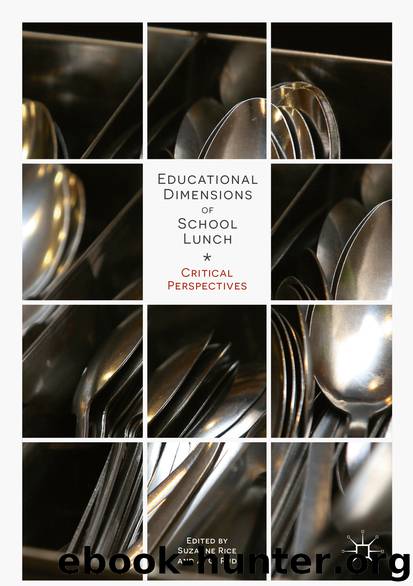Educational Dimensions of School Lunch by Suzanne Rice & A. G. Rud

Author:Suzanne Rice & A. G. Rud
Language: eng
Format: epub
Publisher: Springer International Publishing, Cham
Conceptualizing the commons in this way illuminates the many ways in which aspects of diverse cultures and the environment are enclosed through privatization, commodification, colonization, and modernization. Calling attention to the concept of enclosure in relation to food , Martusewicz et al. (2011) explained, “Unless we grow our own food and husband the animals needed to provide meat, most of our food is provided through grocery stores that acquire food from around the world via a handful of huge privately owned multinational corporations” (p. 214).
Food enclosures refer to the socio-political and economic efforts to enclose and thus limit access to production, preparation, and consumption of local, healthy, and culturally relevant food. For example, affordable healthy food is often expensive and may only be available—if at all—through specialty grocery stores, markets, or big-box stores that can be difficult for marginalized populations to access. Another example of a condition resulting from food enclosures is the existence of food deserts—geographic locations without access to healthy food (Guthman 2011). Community members living within food deserts have little or no access to nourishing food and educational settings that promote food traditions to support physical and cultural health . Often lacking grocery stores, food deserts are geographic locations wherein most people can only access food at fast food restaurants, dollar stores, gas stations, liquor stores, and so on. As part of a larger unjust food distribution system, these types of food establishments are part of a broader distribution system primarily interested in profit and with little interest in or knowledge of local health . In a food desert, processed pre-packaged food—often laden with preservatives and processed sugars—are directly contributing to the failing health of many of the nation’s vulnerable populations.
We assert that school food systems are often full of unhealthy food and harmful food practices for children, and that these conditions are a result of food enclosures. In other words, we assert that food crises are a result of a cultural crisis and the result of a fundamental flaw in how we understand—if we learn at all—the survival imperative of food as part of the commons. Highlighting the importance of the commons as diverse non-monetized aspects of local culture and of local environments, in this chapter we urge educators to consider how food enclosures can be understood and challenged through the recognition of damaging patterns in the daily actions and habits in classrooms. To that end, we share ecocritical lessons learned from the Detroit food movement that challenge us to recognize the importance of both learning that food is a right for all as well as the ways in which we can teach and learn with our students from, and through, radical food policy and activism.
Download
This site does not store any files on its server. We only index and link to content provided by other sites. Please contact the content providers to delete copyright contents if any and email us, we'll remove relevant links or contents immediately.
The Art of Coaching Workbook by Elena Aguilar(50127)
Trainspotting by Irvine Welsh(21043)
Twilight of the Idols With the Antichrist and Ecce Homo by Friedrich Nietzsche(18308)
Fangirl by Rainbow Rowell(8805)
Periodization Training for Sports by Tudor Bompa(7929)
Change Your Questions, Change Your Life by Marilee Adams(7386)
This Is How You Lose Her by Junot Diaz(6458)
Asking the Right Questions: A Guide to Critical Thinking by M. Neil Browne & Stuart M. Keeley(5362)
Grit by Angela Duckworth(5303)
Red Sparrow by Jason Matthews(5203)
Paper Towns by Green John(4808)
Room 212 by Kate Stewart(4742)
Ken Follett - World without end by Ken Follett(4450)
The Sports Rules Book by Human Kinetics(4081)
Housekeeping by Marilynne Robinson(4070)
Double Down (Diary of a Wimpy Kid Book 11) by Jeff Kinney(3936)
Papillon (English) by Henri Charrière(3921)
The Motorcycle Diaries by Ernesto Che Guevara(3793)
Exercise Technique Manual for Resistance Training by National Strength & Conditioning Association(3790)
